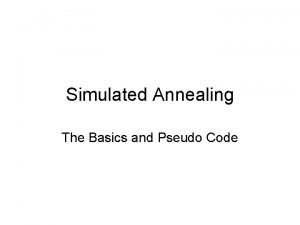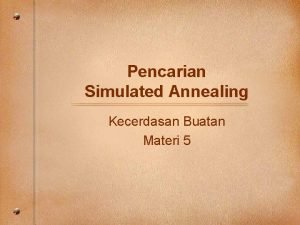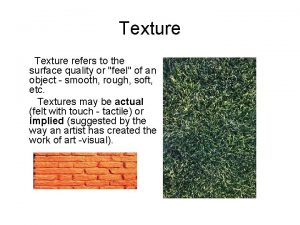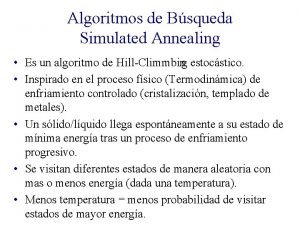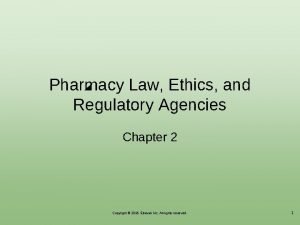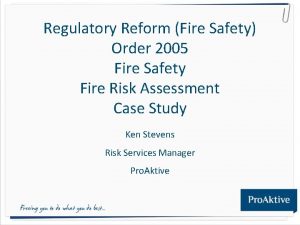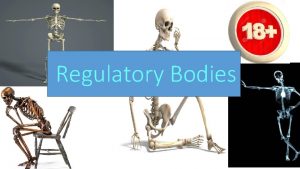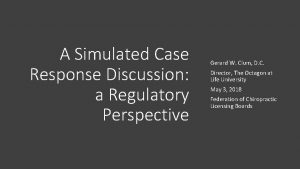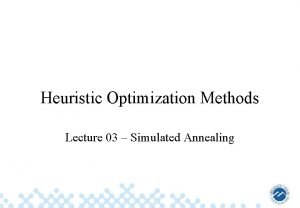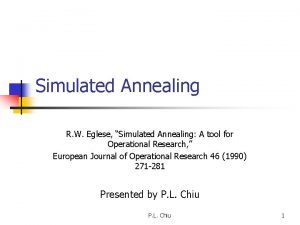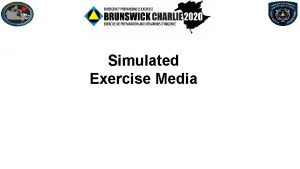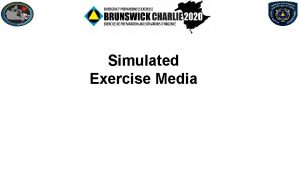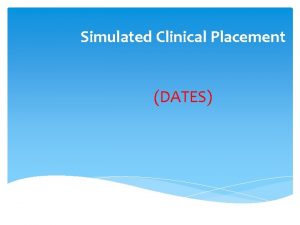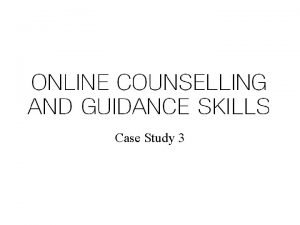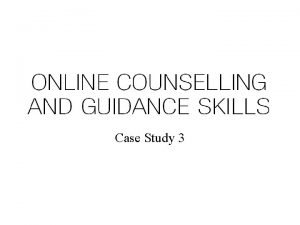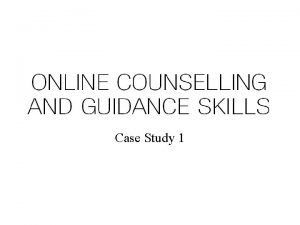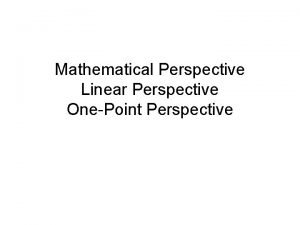A Simulated Case Response Discussion a Regulatory Perspective














































- Slides: 46

A Simulated Case Response Discussion: a Regulatory Perspective Gerard W. Clum, D. C. Director, The Octagon at Life University May 3, 2018 Federation of Chiropractic Licensing Boards

I will not be advocating or discussing any product or third-party service in the context of this presentation Disclosures/Conflicts of Interest I have been, and continue to serve, as a compensated consultant and expert witness, from both the plaintiff and defense perspectives in professional liability and regulatory board matters across the United States, and in Canada I routinely lecture for compensation on this subject to international, state, regional and local chiropractic and legal audiences, as well as, in undergraduate and postgraduate chiropractic educational institutions and settings

Leslie Richards is a 33 year-old, Caucasian female. She is married, the mother of two children ages 5 and 8. Eighteen 24 hours following a chiropractic office visit that included a C 2 supine, diversified modified rotary adjustment she began to experience nausea, vomiting, dizziness, disorientation and loss of lower extremity motor control on the right. She was able to stand but could not walk or bear weight on the right leg. She was transported by ambulance from her home to a university-affiliated hospital that was also a stroke center. She was subsequently diagnosed with a right vertebral artery dissection, and demonstrated altered flow with an obvious intimal flap on MRA examination. She also showed evidence of pontine and right medullary infarcts. She is now 6 months post-stroke with moderate, persistent and likely permanent motor and balance dysfunction together with memory difficulties.

Charles Richards is the husband of Leslie Richards. He is the person who called the emergency services to transport his wife, Leslie. Upon arriving at the university hospital, Mr. Richards spoke with the treating physician and a consulting neuroradiologist. They explained she has had a stroke, at this moment they do not know what the impact of the stroke will be, but she is stable and her condition, at present, is not worsening. The neuroradiologist asked him “does your wife see a chiropractor? ” To which he answers “yes”. “When was her last visit to the chiropractor? ” he questions. “yesterday” responded the husband. The ER physician and neuroradiologist look at each other and the comment is made “well, that’s it”.

Charles Richards “What do you mean, ‘that’s it’ “ Charles asks. The ER physician says “these kinds of strokes happen with chiropractic neck manipulations—I don’t know why they are allowed to continue doing it” Charles attends to the immediate problems his wife is having and once she is home, he revisits the conversation above in his mind and begins to explore a malpractice claim as well as a complaint against the chiropractor involved to the Board of Chiropractic Examiners. He is seeking the actions of the chiropractor be determined to be negligent, or inappropriate, or contraindicated, or unskillful and for the DC be disciplined accordingly.

With the expectation of the wisdom of Solomon, and the unfettered power of the state, Charles Richards wants you to deal with this heinous soul who injured his wife and turned their lives upside-down …negligent, …inappropriate, . . . contraindicated …unskillful Mr. Richards has a right to file a complaint. The Board has an obligation to respond to the complaint The 1 st question becomes “did the chiropractor fail to see something, ask something, or do something that would have prevented this situation? ” The 2 nd question becomes “were there signs the chiropractor shouldn’t have done something he did? ”

What cohorts of individuals generally have a higher risk for stroke? What intake history should a DC ask patients to assess stroke risk? What do you need to know to proceed? What provocative tests should have been done? What care options should be avoided? What informed consent discussion should have been performed? What does a DC do as follow-up when a patient has an adverse reaction to care?

Arterial Dissections 101 Four potential spaces exist 1, The lumen of the artery 2. Between the intima-media 3. Between the media-adven. 4. Outside the vessel

Arterial Dissections 101

Two varieties of stroke: Stroke 101 Hemorrhagic (20%) • Bleeds • “red stroke” Ischemic (80%) • Plugs • “white stroke” Both result is a loss of blood supply, and therefore oxygen to the brain, if long enough to cause brain tissue death a stroke is the result, if not, it is a TIA

Stroke 101 Scenario Dissection—a local problem • Bleeding within the vessel wall (tunica media) • Disruption of the inner lining of the vessel (tunica intima) Yields • Narrowing of the vessel lumenstenosis • Development of thrombi due to irregular blood flow Causes—a systemic problem • <ed blood and oxygen to the brain

Annually, in the U. S. , there will be approximately 750, 000 strokes Cervical artery dissection related strokes represent < 1% of all strokes ~ 7, 000 strokes per year The Basics: frequency Vertebral artery dissections related strokes represent 40% of all cervical artery dissection related strokes ~ 2, 800 per year 99. 1% of strokes have NOTHING to do with this discussion If DC’s see 6. 9% of the population, then a maximum of about 200 of these event could interface with a DC annually

The basics: frequency Cervical artery dissection (Ce. AD), i. e. , Carotid and Vertebral artery dissections, occurs at a rate of 2. 6/100, 00 population. Carotid artery related dissections (CAD) occur at a rate of 1. 6/100, 000 population (60%) Vertebral artery related dissections (VAD) occur at a rate of 1. 0/100, 000 population (40%) 321, 000 x 2. 6/100, 000 = 7, 062; 7, 062 x. 60 = 4, 237; 7. 062 x. 40 = 2, 824 • Cervical artery related dissections (Ce. AD) represent 0. 94% of all strokes • 7, 062/750, 000 = 0. 94% • Carotid artery related dissection (CAD)represent 0. 565% of all strokes • 4, 237/750, 000 = 0. 565% • Vertebral artery related dissections (VAD) represent 0. 375% of all strokes • 2, 824/750, 000 = 0. 375%

The Chiropractic Nexus: Chicken and Egg Old School-causation model Current thinking-association model • Patient develops neck pain • Patient sees chiropractor • Patient gets adjustment • Patient develops stroke symptoms • Chiropractor caused the problem • Patient dissects cervical artery • Dissection yields neck pain • Patient seeks care for neck pain from MD or DC • Patient develops stroke symptoms • MD or DC associated with the stroke but didn’t cause it

Risk of Vertebrobasilar Stroke and Chiropractic Care, Cassidy, SPINE, Volume 13, number 45, pp. S 176 -S 183

Returning to Mr. Richard’s complaint… What cohorts of individuals generally have a higher risk for stroke?

The basics: predisposing conditions Is there a “typical” patient at higher risk for cervical arterial dissection related stroke? • No Are there persons more likely to be prone to arterial dissection? • Yes. Persons with genetically based collagen disorders such as Marfan’s Disease, Loeys-Dietz Syndrome, Ehler-Danlos Syndrome (IV and VI), Autosomal Dominant Polycystic Kidney Disease, Osteogenesis Imperfecta I, (Cystic Medial Degeneration), Fibromuscular Hyperplasia. • People with these conditions are statistically more likely to dissect an artery, (not necessarily a cervical artery) than the rest of the population

The basics: predisposing conditions “A combination of an underlying arteriopathy and a more or less trivial precipitating event is likely the mechanism of spontaneous cervical dissections” “…multiple low-risk genetic variants may also contribute to a generalized constitutional weakness of the arterial wall” “The underlying arteriopathy, however, does not have to be genetically determined and permanent but may be transient, possibly caused by an infectious agent. ” Schievink, Neurology 2011; 76; 1452

The basics: theorized predisposing conditions reflected in the literature • Migraine • Hyperhomocysteinemia • Hyperlipedemia • Hypertension • Previous respiratory infection There were no differences in prevalence of strokes, arterial distribution, or other clinical or prognostic features between migrainous and nonmigrainous Ce. AD patients Although Ce. AD is often complicated by stroke, our data do not support increased risk of stroke in migrainous Ce. AD patients -Migraine in cervical artery dissection and ischemic stroke patients, Metso, T. et al. Neurology® 2012; 78: 1221– 1228

The basics: theorized predisposing conditions reflected in the literature • Migraine • Hyperhomocysteinemia • Hyperlipedemia • Hypertension • Previous respiratory infection The study sample comprised 690 CEAD patients, 556 patients with a non-CEAD IS, and 1170 referents. We compared the prevalence of… hypercholesterolemia between the 3 groups using a multinomial logistic regression. Compared with referents, CEAD patients had a lower prevalence of hypercholesterolemia, obesity and overweightness --Association of Vascular Risk Factors With Cervical Artery Dissection and Ischemic Stroke in Young Adults, De. Bette, S. Circulation. 2011; 123: 1537 -1544

The basics: theorized predisposing conditions reflected in the literature • • • These results, from the largest series to date, Migraine suggest that hypertension, although less prevalent than in patients with a non-CEAD IS, could be a risk Hyperhomocysteinemia factor of CEAD…Compared with non-CEAD IS Hyperlipedemia patients, CEAD patients had a significantly lower prevalence of hypertension… Hypertension Although hypertension is usually considered one of Previous respiratory infection the major risk factors for aortic dissection, its association with CEAD is controversial --Association of Vascular Risk Factors With Cervical Artery Dissection and Ischemic Stroke in Young Adults, De. Bette, S. Circulation. 2011; 123: 1537 -1544

The basics: age, sex, race Is there a patient demogrphic to be concerned about? • Age: Cervical artery dissections (carotid or vertebral) represent 10%-25% of strokes in persons </= 45 years of age. After age 45, the incidence of cervical artery dissection stroke drops precipitously. 70% of cervical artery dissections occur between the ages of 30 and 50, <10% before 30, 7% at or after 60 • Sex: Questionable, but appears to be slightly more frequent among men and but occur on average 5 years younger in women. There are variances in the literature in both directions • Race: No identified propensity based upon race

75% of vertebral artery dissection patients will make a good recovery The basics: outcomes 20% of vertebral artery dissection patients will be left with significant impairment 5% of vertebral artery dissection patients will die as a result of the arterial dissection Therefore, If 2, 800 VA dissections occur annually then 140 deaths will ensue annually

Returning to Mr. Richard’s complaint… What intake history should a DC ask patients to assess stroke risk? What provocative tests should have been done?

If the patient presents with recent onset neck pain and/or headache the history should include: • Location of the pain • Character of the pain • Information about onset • First occurrence of the problem • Information about aggravators • Inquiry about any other neurological symptoms or conditions accompanying the pain • Unusual movements, lifting or recreational/athletic activity • History of HA, aneurysm, arterial dissection, TIA or stroke in family • History of any of the heritable conditions noted, Marfan’s etc. “should”, “average” and “standard of care” are NOT interchangeable terms or expectations.

If the patient presents with recent onset neck pain and/or headache the physical should include: • A cervical spine evaluation including static palpation, range of motion, orthopedic testing, basic neurological examination (ideally including the Cranial Nerves), evaluation of muscular tone etc. are appropriate • There are no accepted and validated tests to assess carotid or vertebral artery patency and sufficiency. George’s Test, De. Klyne’s Test etc. are unreliable. • Typical cardiovascular concerns such as hypertension and hyperlipidemia do not inform this situation

What should providers be alert to? Vertebrobasilar Stroke Following Manipulation 1996 Terrett, A. NCMIC

Hearing the following phrase, or something close to it, from a patient: What should providers be alert to? “I have a pain in my head (or) neck unlike any pain I have ever had before in my life” Not necessarily the worst, or most severe, rather the most unusual pain the person has experienced in their head/neck

Returning to Mr. Richard’s complaint… What care options should be avoided?

Should any particular type of adjusting be avoided? “Thus, given the current state of the literature, it is impossible to advise patients or physicians about how to avoid vertebrobasilar artery dissection when considering cervical manipulation or about specific sports or exercises that result in neck movement or trauma. ” (Haldeman et al, Spine 1999)

a. Neutral b. Intermediate Changes in Vertebral Artery Blood Flow Following Various Head Positions and Cervical Spine Manipulation, Quesnelle, J. et al, JMPT: 37; 1 Images courtesy of John Triano, DC, Ph. D c. Maximal

Returning to Mr. Richard’s complaint… What informed consent discussion should have been performed?

It is a prudent and appropriate process to engage in with all patients It may be required by law Informed consent? It may be required as an element of membership in a professional body It may be a contractual requirement of employment or participation in a managed care setting

Informed consent? Provides important information for the patient to be more informed, knowledgeable and engaged in their care Provides important protection for the practitioner in the event of an adverse outcome of care that was discussed as part of the informed consent It is an ongoing process as opposed to a one-off task of completing a form

Informed consent and reality Regardless of the best efforts of providers, patients often disregard the process and take a laissez faire approach to it and undermine the protective value for the patient Providers often do not perfect the delivery of an informed consent process and therein undermine its protective value for the provider It is practically impossible to provide a meaningful and complete informed consent in this environment

It is practically impossible to provide a meaningful and complete informed consent in this environment There is no confirmed and accepted number of cervical artery dissections upon which to base a likelihood of occurrence There is no confirmed and accepted number of cervical artery dissections associated with chiropractic care There has been the determination of an association between cervical artery dissection and manual spinal care for any provider group There has been no determination of cervical artery dissection as a result of manual spinal care for any provider group

Returning to Mr. Richard’s complaint… What does a DC do as follow-up when a patient has an adverse reaction to care?

VAD Symptoms Following an Adjustment Management and documentation of the situation are the most important issues in reducing morbidity and mortality, as well as in limiting or reducing liability. Recognition of the post-adjustment symptomatic picture is critical. You cannot assume that because VAD is extremely rare that it won’t, didn’t or can’t happen in your office.

Any of 5 D’s, an A or any of the 3 N’s should cause you to pay attention immediately. What should I do? If the symptoms are mild, monitor them for their decrease or their resolution If severe, consider emergency services immediately

Each situation will require a different response What should I do? Always monitor the patient’s vitals, as well as specific neurological responses that drew attention Availability of baseline vitals will allow this data to be more meaningful

If the symptoms are very transient, limited and resolve quickly, take a position of “watchful waiting” What should I do? Consider the area adjusted, the type of adjustment given, and if an alternate approach would be in order Do not readjust the patient at this time

If the symptoms do NOT resolve quickly, monitor the patient and stay with the patient, no matter how the waiting room is backed up. What should I do? Watch for the development of additional symptoms, note the mental status, degree of confusion if any, etc. If symptoms persist, or if they worsen, seek emergency services support. Monitor the patient while waiting for support services. Do not readjust the patient at this time.

If a patient demonstrates signs of an adverse reaction to care, specifically signs and symptoms of a TIA or stroke… Note the time, Call EMS • Evaluate FAST- Face drooping, Arm weakness, Speech difficulty, Time since onset, assess to the degree reasonable any other deficiencies particularly related to the cerebellum and Cranial Nerve activity • Stay with the patient-be in attendance at all times and place the patient in a side-lying position • When EMS arrive relate the time information and results of your FAST screening and neurologic assessment • After the patient leaves the office with EMS document your record as completely as possible

Your decision making… Were there any signs, inputs, or findings suggestive of a cervical artery dissection or posterior circulation stroke? • Red flags on presentation? • Suspicions developed from the history? • Concerning results from the physical? • Comments from the patient? • Mismanagement of a complicating situation?

I understand your primary role is protection of the public I also understand hindsight is 20/20 Your decision making… Evaluating a situation fairly to all parties is essential Was there truly something that was present that a reasonable DC in your state would (as opposed to could) see as a concern?

I hope this information and these perspectives will be useful to you in the task you have been called to perform My thanks to President Colucci for the invitation to present as well as to Dr. Schwartzbaurer and staff for their assistance and cooperation My thanks also to Chancellor Riekeman and President Scott of Life University for the release time to prepare and present this discussion Gerard W. Clum, D. C. gerrycdc@aol. com drgerryclum. com
 Best worst and average case
Best worst and average case Introduction of fractional distillation
Introduction of fractional distillation Simulated annealing pseudo code
Simulated annealing pseudo code Contoh simulated annealing
Contoh simulated annealing Actual texture
Actual texture Texture actual
Texture actual Exodeviation
Exodeviation Simulated forgery definition forensics
Simulated forgery definition forensics Texture is the surface quality
Texture is the surface quality Actual, simulated, abstract, and invented texture.
Actual, simulated, abstract, and invented texture. Algoritmo
Algoritmo Tone or value
Tone or value Simulated killing philosophy
Simulated killing philosophy The actual surface feel of the simulated appearance
The actual surface feel of the simulated appearance Exit test 1
Exit test 1 The actual surface feel of the simulated appearance
The actual surface feel of the simulated appearance Zaner blosser
Zaner blosser Two point perspective staircase
Two point perspective staircase Silo perspective vs business process perspective
Silo perspective vs business process perspective Natural response and forced response
Natural response and forced response Natural response and forced response example
Natural response and forced response example A subsequent
A subsequent Case based discussion template nhs
Case based discussion template nhs Incident response technologies
Incident response technologies Unit 3 assessing risk in sport
Unit 3 assessing risk in sport Dispositional framework vs regulatory framework
Dispositional framework vs regulatory framework Orange diamond shaped signs warn the motorist of
Orange diamond shaped signs warn the motorist of Regulatory framework for financial services in india
Regulatory framework for financial services in india Chapter 22 regulatory and advisory agencies
Chapter 22 regulatory and advisory agencies Chapter 2 pharmacy law ethics and regulatory agencies
Chapter 2 pharmacy law ethics and regulatory agencies Infection control cosmetology
Infection control cosmetology Functions of sebi
Functions of sebi Functions of financial system
Functions of financial system Regulatory change management process
Regulatory change management process Objectives of irdai
Objectives of irdai Diversity and regulatory challenges
Diversity and regulatory challenges Traffic sign color meanings
Traffic sign color meanings Basle ii
Basle ii Regulatory capital vs economic capital
Regulatory capital vs economic capital Metoda linii pierwiastkowych
Metoda linii pierwiastkowych Gene regulatory network
Gene regulatory network State nuclear regulatory inspectorate of ukraine
State nuclear regulatory inspectorate of ukraine Round yellow sign with black markings
Round yellow sign with black markings Gene regulatory network
Gene regulatory network Regulatory reform fire safety order 2005
Regulatory reform fire safety order 2005 Film regulatory bodies
Film regulatory bodies Nespojité regulátory
Nespojité regulátory


